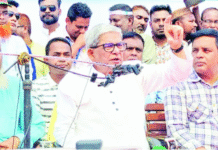Analysts say Bangladesh may lose market competitiveness due to a huge wage hike, but Tk 600 increase is not acceptable
 A 20 percent rise in wages is too minimal, while a 170 percent hike is too high. It begs the question: Why this huge disparity between the garment workers’ expectations and the reality?
A 20 percent rise in wages is too minimal, while a 170 percent hike is too high. It begs the question: Why this huge disparity between the garment workers’ expectations and the reality?
The workers’ representative on the wage board called for raising the minimum wage to Tk 8,114 a month from the current Tk 3,000, but the owners are willing to increase it only by Tk 600.
“An industry that operates in a competitive global landscape will simply not be able to sustain the pay rise that the workers are demanding,” said Mustafizur Rahman, executive director of the Centre for Policy Dialogue (CPD).
He singled out the small and medium factories, which would be hit hard by the 170.5 percent wage rise “given the local and global trends of business”.
In an industry of 4,000, there are 2,200 small and medium factories, according to Arshad Jamal Dipu, owners’ representative on the wage board. “That is more than 50 percent of the industry would be unable to bear the huge hike in salary.”
“But then again, a 20 percent wage rise that the owners are pushing for would not make much difference in the workers’ living conditions,” said Mustafizur of the CPD.
He, therefore, called for a median pay rise, one that allows the industry to maintain competitiveness and profitability and at once affords the workers “a decent life”.
The CPD executive director, however, has declined to give a figure as the think-tank is scheduled to present a paper on the matter in a seminar today at the Cirdap auditorium.
Sirajul Islam Rony, workers’ representative on the wage board, said that the Tk 8,114 figure was arrived at after taking the workers’ basic needs into consideration.
Their proposed minimum wage makes monthly allowance for: food Tk 2,189, rent Tk 3,000 and medical Tk 500. But the owners are only willing to cover for food Tk 2,400, rent Tk 960 and medical allowance Tk 240.
The workers also want allowance for clothing, conveyance, recreation, personal grooming, festivals and refreshment, but the owners refuse to give any.
The proposal that roused the workers to take to the streets is now seen as a source of all troubles.
Sadiq Ahmed, vice-chairman of Policy Research Institute (PRI), said the impact of salary hike by such margins on the cost of production had to be considered.
“The production cost has already been increasing by nearly 13 percent every year — incorporating that salary hike would send the cost through the roof.”
Moreover, the pay rise is likely to shut the door for the currently unemployed pool of workers, the PRI vice-chairman says.
“If the garment owners increase the salary to a large extent for a limited number of workers, would they be able to afford any new hires? That has to be considered too when bargaining for a higher minimum wage.”
The country’s main advantage is its surplus labour, so the wage should be fixed in such a way that it makes the best use of the boon. “As things stand, we can divert much surplus labour from the agricultural sector to manufacturing.”
Sadiq cited the case of China, whose undisputed position as the number one apparel supplier in the world is dissipating due to rising costs of production by way of high wages.
“The safety and security of the workers should also be taken into cognisance while fixing the salaries of the workers,” he added.
After extensive criticism from around the globe, the government in May announced a new wage board to fix the salaries of the 3.6 million garment workers.
The minimum wage for the garment workers was first fixed at Tk 627 in 1985, which was increased to Tk 930 in 1994. Then in 2006, the garment workers were handed out a 78.79 percent pay rise, which was raised to the current level of Tk 3,000 in 2010.
Source: The Daily Star









